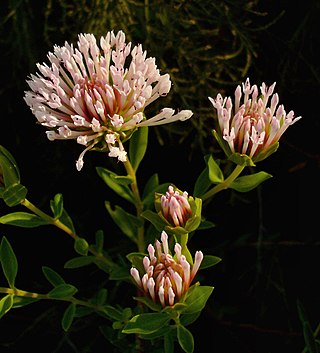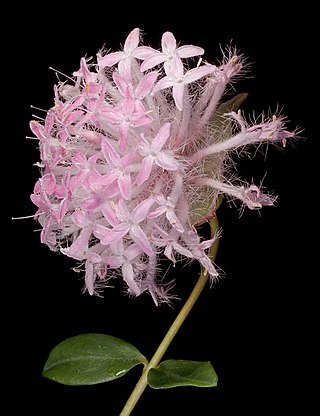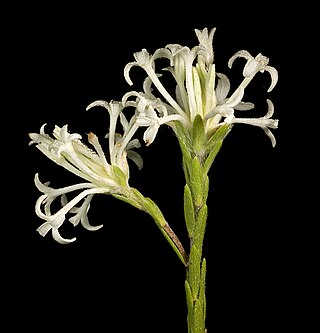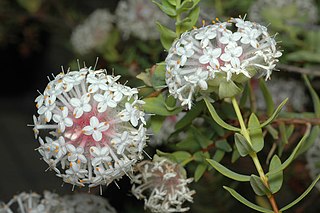
Pimelea calcicola is a species of flowering plant in the family Thymelaeaceae and is endemic to part of the west coast of Western Australia. It is an erect to spreading shrub with elliptic leaves arranged in opposite pairs, and head-like racemes of pale to deep pink, tube-shaped flowers surrounded by leaf-like involucral bracts.

Pimelea ferruginea, commonly known as pink rice flower or coastal banjine, is a species of flowering plant in the family Thymelaeaceae and is endemic to near-coastal areas of south-western Western Australia. It is a dense, erect shrub with elliptic to narrowly elliptic leaves and head-like clusters of pale to deep pink, tube-shaped flowers.

Pimelea hispida, commonly known as bristly pimelea, is a species of flowering plant in the family Thymelaeaceae and is endemic to the southwest of Western Australia. It is an erect shrub with elliptic leaves and erect clusters of pink flowers surrounded by 4 green involucral bracts.

Pimelea longiflora is a species of flowering plant in the family Thymelaeaceae and is endemic to the southwest of Western Australia. It is an erect, spindly shrub with linear to narrowly elliptic leaves and erect clusters of white to cream-coloured flowers, surrounded by 4 to 6 green, egg-shaped involucral bracts.

Pimelea avonensis is a species of flowering plant in the family Thymelaeaceae and is endemic to the south-west of Western Australia. It is a shrub with narrowly egg-shaped or elliptic leaves and clusters of white, tube-shaped flowers.
Pimelea brevifolia is a species of flowering plant in the family Thymelaeaceae and is endemic to the south-west of Western Australia. It is an undershrub or shrub with erect, elliptic leaves, and heads of white flowers surrounded by four involucral bracts.

Pimelea brevistyla is a species of flowering plant in the family Thymelaeaceae and is endemic to the south-west of Western Australia. It is a shrub with narrowly egg-shaped leaves arranged in opposite pairs, and head-like racemes of white, tube-shaped flowers surrounded by yellowish involucral bracts.
Pimelea concreta is a species of flowering plant in the family Thymelaeaceae and is native to northern Australia and parts of Indonesia. It is an annual herb with narrowly egg-shaped leaves and head-like clusters of white or pink, tube-shaped flowers surrounded by egg-shaped green involucral bracts.

Pimelea cracens is a species of flowering plant in the family Thymelaeaceae and is endemic to the southwest of Western Australia. It is an erect, spindly shrub with narrowly elliptic to egg-shaped leaves and creamy green to pale yellow flowers surrounded by 6 or 8 yellowish or pale green and reddish involucral bracts.
Pimelea drummondii is a species of flowering plant in the family Thymelaeaceae and is endemic to near-coastal areas of southern Western Australia. It is an erect, slender shrub with narrowly elliptic or elliptic leaves arranged in opposite pairs, and white or cream-coloured flowers surrounded by 3 or 4 pairs of pale green to yellowish involucral bracts.
Pimelea erecta is a species of flowering plant in the family Thymelaeaceae and is endemic to the southwest of Western Australia. It is an erect, often spreading shrub with elliptic to egg-shaped leaves arranged in opposite pairs, and clusters of erect, white or pale pink flowers.
Pimelea eyrei is a species of flowering plant in the family Thymelaeaceae and is endemic to the southwest of Western Australia. It is an erect shrub with hairy, narrowly elliptic leaves and clusters of densely hairy, white or cream-coloured flowers.
Pimelea gilgiana is a species of flowering plant in the family Thymelaeaceae and is endemic to near-coastal areas of north-western Western Australia. It is a shrub with narrowly egg-shaped leaves and head-like clusters of white or pinkish, dioecious flowers.
Pimelea halophila is a species of flowering plant in the family Thymelaeaceae and is endemic to the southwest of Western Australia. It is an undershrub with elliptic leaves and compact clusters of 4 to 20 cream-coloured or white flowers surrounded by 3 or 4 green involucral bracts, and grows on islands in salt lakes.
Pimelea holroydii is a species of flowering plant in the family Thymelaeaceae and is endemic to the north of Western Australia. It is an erect shrub with egg-shaped leaves arranged more or less in opposite pairs, and head-like clusters of white or cream-coloured, tube-shaped flowers.
Pimelea lanata is a species of flowering plant in the family Thymelaeaceae and is endemic to the southwest of Western Australia. It is a shrub with narrowly elliptic leaves and erect clusters of white to deep pink flowers surrounded by 4, mostly green, involucral bracts.

Pimelea lehmanniana is a species of flowering plant in the family Thymelaeaceae and is endemic to the southwest of Western Australia. It is a shrub with narrowly egg-shaped leaves and clusters of white to pale yellow flowers surrounded by 4 or 6, pale yellowish-green involucral bracts.

Pimelea leucantha is a species of flowering plant in the family Thymelaeaceae and is endemic to near-coastal areas in the west of Western Australia. It is a shrub with linear to narrowly egg-shaped or narrowly elliptic leaves and clusters of white to pale yellow flowers surrounded by 4 or 6 egg-shaped involucral bracts.
Pimelea neokyrea is a species of flowering plant in the family Thymelaeaceae and is endemic to the southwest of Western Australia. It is a low, spreading shrub with narrowly egg-shaped to narrowly ellipic leaves and erect clusters of white or pale yellow flowers surrounded by egg-shaped involucral bracts. It was previously included in Pimelea avonensis.
Pimelea pendens is a species of flowering plant in the family Thymelaeaceae and is endemic to the southwest of Western Australia. It is an erect, spindly with egg-shaped to narrowly elliptic leaves and compact, pendulous clusters of pale green flowers surrounded by 2 to 4 pairs of green or yellowish-green involucral bracts.









